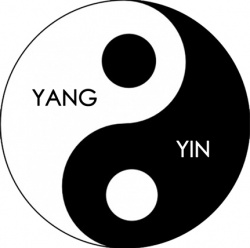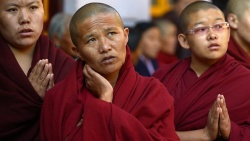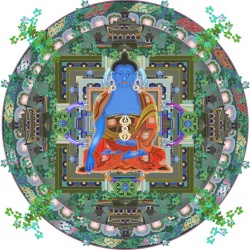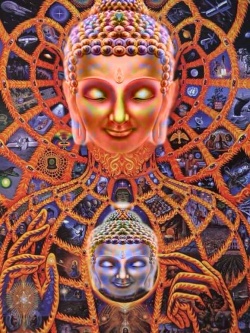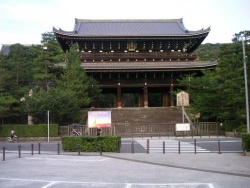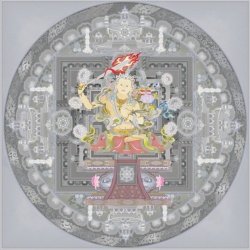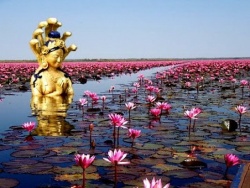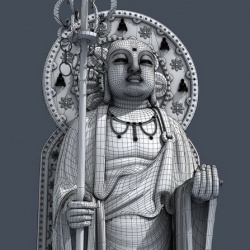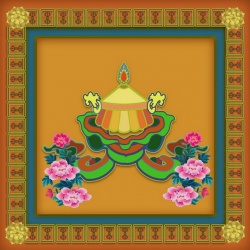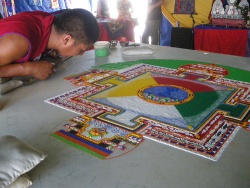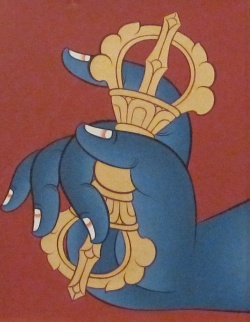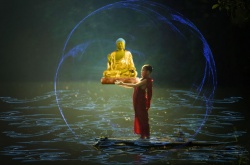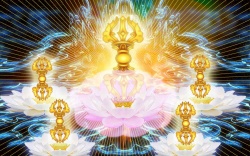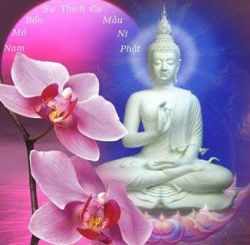Difference between revisions of "Yin Yang"
| (6 intermediate revisions by the same user not shown) | |||
| Line 1: | Line 1: | ||
| − | [[File:2014-06-23-yinyang.jpg|thumb|250px|]] | + | [[File:2014-06-23-yinyang.jpg|thumb|250px|]]<nomobile>{{DisplayImages|2815|1019|3653|2405|3228|838|531|657|1355|2159|4133|3611|4356|4422|3762}}</nomobile> |
| Line 52: | Line 52: | ||
Compare these Middle {{Wiki|Chinese}} and Old {{Wiki|Chinese}} (with asterisk) reconstructions of yīn [[陰]] and [[yáng]] [[陽]]: | Compare these Middle {{Wiki|Chinese}} and Old {{Wiki|Chinese}} (with asterisk) reconstructions of yīn [[陰]] and [[yáng]] [[陽]]: | ||
| − | |||
| − | |||
| − | |||
| − | |||
| − | |||
| − | |||
| − | |||
| − | |||
| − | |||
| Line 66: | Line 57: | ||
Schuessler gives probable [[Sino-Tibetan]] etymologies for both {{Wiki|Chinese}} words. | Schuessler gives probable [[Sino-Tibetan]] etymologies for both {{Wiki|Chinese}} words. | ||
| − | [[Yin]] | + | [[Yin]]əm compares with [[Burmese]] um "overcast; cloudy", Adi muk-jum "shade", and Lepcha so'yǔm "shade"; and is probably {{Wiki|cognate}} with {{Wiki|Chinese}} àn *ə̂m 黯 "dim; gloomy" and qīn *khəm 衾 "blanket" |
| − | Yang | + | [[Yang]] *laŋ compares with Lepcha a-lóŋ "{{Wiki|reflecting}} {{Wiki|light}}", [[Burmese]] laŋB "be bright" and ə-laŋB "{{Wiki|light}}", and Tai plaŋA1 "bright"; and is perhaps {{Wiki|cognate}} with {{Wiki|Chinese}} chāng *k-hlaŋ 昌 "[[prosperous]]; bright" (cf. Proto-Viet-Mong hlaŋB "bright"), and bǐng *braŋ 炳 "bright". |
Meanings | Meanings | ||
| − | Yin and yang are semantically complex words. | + | [[Yin and yang]] are {{Wiki|semantically}} complex words. |
| − | A reliable Chinese-English dictionary gives the following translation equivalents. | + | A reliable Chinese-English {{Wiki|dictionary}} gives the following translation equivalents. |
| − | Yin 陰 or 阴 Noun ① [philosophy] negative/passive/female principle in nature ② Surname Bound morpheme ① the moon ② shaded orientation ③ covert; concealed; hidden ④ ⑦ negative ⑧ north side of a hill ⑨ south bank of a river ⑩ reverse side of a stele ⑪in intaglio Stative verb ① overcast ② sinister; treacherous | + | [[Yin]] [[陰]] or [[阴]] Noun ① [[[philosophy]]] negative/passive/female [[principle]] in [[nature]] ② Surname [[Bound]] morpheme ① the [[moon]] ② shaded orientation ③ covert; concealed; hidden ④ ⑦ negative ⑧ [[north]] side of a hill ⑨ [[south]] bank of a [[river]] ⑩ reverse side of a stele ⑪in intaglio Stative verb ① overcast ② sinister; treacherous |
| − | Yang 陽 or 阳 Bound morpheme ① [Chinese philosophy] positive/active/male principle in nature ②the sun ④ in relief ⑤ open; overt ⑥ belonging to this world ⑦ [linguistics] masculine ⑧ south side of a hill ⑨ north bank of a river | + | [[Yang]] [[陽]] or [[阳]] [[Bound]] morpheme ① [[[Chinese philosophy]]] positive/active/male [[principle]] in [[nature]] ②the {{Wiki|sun}} ④ in relief ⑤ open; overt ⑥ belonging to this [[world]] ⑦ [{{Wiki|linguistics}}] {{Wiki|masculine}} ⑧ [[south]] side of a hill ⑨ [[north]] bank of a [[river]] |
| − | The compound yinyang 陰陽 or 阴阳 means "yin and yang; opposites; ancient Chinese astronomy; occult arts; astrologer; geomancer; etc.". | + | The compound [[yinyang]] [[陰陽]] or [[阴阳]] means "[[yin and yang]]; opposites; [[ancient]] {{Wiki|Chinese astronomy}}; [[occult]] [[arts]]; [[astrologer]]; [[geomancer]]; etc.". |
| − | The Sinologist Rolf Stein etymologically translates Chinese yin 陰 "shady side (of a mountain)" and yang 陽 "sunny side (of a mountain)" with the uncommon English geographic terms ubac "shady side of a mountain" and adret "sunny side of a mountain" (which are of French origin). | + | The [[Sinologist]] {{Wiki|Rolf Stein}} {{Wiki|etymologically}} translates {{Wiki|Chinese}} [[yin]] [[陰]] "shady side (of a mountain)" and [[yang]] [[陽]] "sunny side (of a mountain)" with the uncommon English geographic terms ubac "shady side of a mountain" and adret "sunny side of a mountain" (which are of {{Wiki|French}} origin). |
| Line 95: | Line 86: | ||
| − | Many Chinese place names or toponyms contain the word yang "sunny side" and a few contain yin "shady side". In China, as elsewhere in the Northern Hemisphere, sunlight comes predominantly from the south, and thus the south face of a mountain or the north bank of a river will receive more direct sunlight than the opposite side. | + | Many {{Wiki|Chinese}} place names or toponyms contain the [[word]] [[yang]] "sunny side" and a few contain [[yin]] "shady side". In [[China]], as elsewhere in the {{Wiki|Northern Hemisphere}}, sunlight comes predominantly from the [[south]], and thus the [[south]] face of a mountain or the [[north]] bank of a [[river]] will receive more direct sunlight than the opposite side. |
| − | Yang refers to the "south side of a hill" in Hengyang 衡陽, which is south of Mount Heng 衡山 in Hunan province, and to the "north bank of a river" in Luoyang 洛陽, which is located north of the Luo River 洛河 in Henan. | + | [[Yang]] refers to the "[[south]] side of a hill" in [[Hengyang]] 衡陽, which is [[south]] of [[Mount Heng]] 衡山 in [[Hunan province]], and to the "[[north]] bank of a [[river]]" in [[Luoyang]] [[洛陽]], which is located [[north]] of the {{Wiki|Luo River}} 洛河 in {{Wiki|Henan}}. |
| − | Similarly, yin refers to "north side of a hill" in Huayin 華陰, which is north of Mount Hua 華山 in Shaanxi province. | + | Similarly, [[yin]] refers to "[[north]] side of a hill" in {{Wiki|Huayin}} 華陰, which is [[north]] of [[Mount Hua]] 華山 in {{Wiki|Shaanxi province}}. |
| Line 107: | Line 98: | ||
| − | English yin, yang, and yin-yang are familiar loanwords of Chinese origin. | + | English [[yin]], [[yang]], and [[yin-yang]] are familiar loanwords of {{Wiki|Chinese}} origin. |
| − | The Oxford English Dictionary defines: | + | The {{Wiki|Oxford}} English {{Wiki|Dictionary}} defines: |
| − | yin (jɪn) Also Yin, Yn. [Chinese yīn shade, feminine; the moon.] | + | [[yin]] (jɪn) Also [[Yin]], Yn. [{{Wiki|Chinese}} yīn shade, {{Wiki|feminine}}; the [[moon]].] |
| − | a. In Chinese philosophy, the feminine or negative principle (characterized by dark, wetness, cold, passivity, disintegration, etc.) of the two opposing cosmic forces into which creative energy divides and whose fusion in physical matter brings the phenomenal world into being. Also attrib. or as adj., and transf. Cf. yang. | + | a. In [[Chinese philosophy]], the {{Wiki|feminine}} or negative [[principle]] (characterized by dark, {{Wiki|wetness}}, cold, passivity, {{Wiki|disintegration}}, etc.) of the two opposing [[cosmic]] forces into which creative [[energy]] divides and whose fusion in [[physical]] {{Wiki|matter}} brings the [[phenomenal world]] into being. Also attrib. or as adj., and transf. Cf. [[yang]]. |
| − | b. Comb., as yin-yang, the combination or fusion of the two cosmic forces; freq. attrib., esp. as yin-yang symbol, a circle divided by an S-shaped line into a dark and a light segment, representing respectively yin and yang, each containing a 'seed' of the other. | + | b. Comb., as [[yin-yang]], the combination or fusion of the two [[cosmic]] forces; freq. attrib., esp. as [[yin-yang]] [[symbol]], a circle divided by an S-shaped line into a dark and a {{Wiki|light}} segment, representing respectively [[yin and yang]], each containing a 'seed' of the other. |
| − | yang (jæŋ) Also Yang. [Chinese yáng yang, sun, positive, male genitals.] | + | [[yang]] (jæŋ) Also [[Yang]]. [{{Wiki|Chinese}} [[yáng]] [[yang]], {{Wiki|sun}}, positive, {{Wiki|male}} genitals.] |
| − | a. In Chinese philosophy, the masculine or positive principle (characterized by light, warmth, dryness, activity, etc.) of the two opposing cosmic forces into which creative energy divides and whose fusion in physical matter brings the phenomenal world into being. Also attrib. or as adj. Cf. yin. | + | a. In [[Chinese philosophy]], the {{Wiki|masculine}} or positive [[principle]] (characterized by {{Wiki|light}}, warmth, dryness, [[activity]], etc.) of the two opposing [[cosmic]] forces into which creative [[energy]] divides and whose fusion in [[physical]] {{Wiki|matter}} brings the [[phenomenal world]] into being. Also attrib. or as adj. Cf. [[yin]]. |
| − | b. Comb.: yang-yin = yin-yang s.v. yin b. | + | b. Comb.: [[yang-yin]] = [[yin-yang]] s.v. [[yin]] b. |
| − | For the earliest recorded "yin and yang" usages, the OED cites 1671 for yin and yang, 1850 for yin-yang, and 1959 for yang-yin. | + | For the earliest recorded "[[yin and yang]]" usages, the OED cites 1671 for [[yin and yang]], 1850 for [[yin-yang]], and 1959 for [[yang-yin]]. |
| − | In English, yang-yin (like ying-yang) occasionally occurs as a mistake or typographical error for the Chinese loanword yin- | + | In English, [[yang-yin]] (like [[ying-yang]]) occasionally occurs as a mistake or typographical error for the {{Wiki|Chinese}} loanword [[yin-yang]]— yet they are not equivalents. {{Wiki|Chinese}} does have some [[yangyin]] collocations, such as 洋銀 (lit. "foreign {{Wiki|silver}}") "{{Wiki|silver}} coin/dollar", |
| − | but not even the most comprehensive dictionaries (e.g., the Hanyu Da Cidian) enter yangyin *陽陰. While yang and yin can occur together in context, yangyin is not synonymous with yinyang. | + | but not even the most comprehensive dictionaries (e.g., the Hanyu Da Cidian) enter [[yangyin]] *陽陰. While [[yang]] and [[yin]] can occur together in context, [[yangyin]] is not {{Wiki|synonymous}} with [[yinyang]]. |
| − | The linguistic term "irreversible binomial" refers to a collocation of two words A-B that cannot normally be reversed as B-A, for example, English cat and mouse (not *mouse and cat) and friend or foe (not *foe or friend). | + | The {{Wiki|linguistic}} term "irreversible binomial" refers to a collocation of two words A-B that cannot normally be reversed as B-A, for example, English {{Wiki|cat}} and {{Wiki|mouse}} (not *{{Wiki|mouse}} and {{Wiki|cat}}) and [[friend]] or foe (not *foe or [[friend]]). |
| − | Similarly, the usual pattern among Chinese binomial compounds is for positive A and negative B, where the A word is dominant or privileged over B, for example, tiandi 天地 "heaven and earth" and nannü 男女 "men and women". Yinyang meaning "dark and light; female and male; moon and sun", however, is an exception. | + | Similarly, the usual pattern among {{Wiki|Chinese}} binomial compounds is for positive A and negative B, where the A [[word]] is dominant or privileged over B, for example, tiandi 天地 "[[heaven]] and [[earth]]" and nannü 男女 "men and women". [[Yinyang]] meaning "dark and {{Wiki|light}}; {{Wiki|female}} and {{Wiki|male}}; [[moon]] and {{Wiki|sun}}", however, is an exception. |
| − | Scholars have proposed various explanations for why yinyang violates this pattern, including "linguistic convenience" (it is easier to say yinyang than yangyin), | + | [[Scholars]] have proposed various explanations for why [[yinyang]] violates this pattern, including "{{Wiki|linguistic}} convenience" (it is easier to say [[yinyang]] than [[yangyin]]), |
| − | the idea that "proto-Chinese society was matriarchal", or perhaps, since yinyang first became prominent during the late Warring States period, this term was "purposely directed at challenging persistent cultural assumptions". | + | the [[idea]] that "proto-Chinese [[society]] was {{Wiki|matriarchal}}", or perhaps, since [[yinyang]] first became prominent during the late [[Warring States period]], this term was "purposely directed at challenging persistent {{Wiki|cultural}} {{Wiki|assumptions}}". |
| − | Nature | + | [[Nature]] |
| − | In Daoist philosophy, dark and light, yin and yang, arrive in the Tao Te Ching at chapter 42. | + | In {{Wiki|Daoist philosophy}}, dark and {{Wiki|light}}, [[yin and yang]], arrive in the [[Tao Te Ching]] at [[chapter]] 42. |
| − | It becomes sensible from an initial quiescence or emptiness (wuji, sometimes symbolized by an empty circle), and continues moving until quiescence is reached again. | + | It becomes sensible from an initial quiescence or [[emptiness]] ([[wuji]], sometimes [[symbolized]] by an [[empty]] circle), and continues moving until quiescence is reached again. |
| − | For instance, dropping a stone in a calm pool of water will simultaneously raise waves and lower troughs between them, and[citation needed] this alternation of high and low points in the water will radiate outward until the movement dissipates and the pool is calm once more. | + | For instance, dropping a stone in a [[calm]] pool of [[water]] will simultaneously raise waves and lower troughs between them, and[citation needed] this alternation of high and low points in the [[water]] will radiate outward until the {{Wiki|movement}} dissipates and the pool is [[calm]] once more. |
| − | Yin and yang thus are always opposite and equal qualities. | + | [[Yin and yang]] thus are always opposite and {{Wiki|equal}} qualities. |
| − | Further, whenever one quality reaches its peak, it will naturally begin to transform into the opposite quality: for example, grain that reaches its full height in summer (fully yang) will produce seeds and die back in winter (fully yin) in an endless cycle. | + | Further, whenever one [[quality]] reaches its peak, it will naturally begin to [[transform]] into the opposite [[quality]]: for example, grain that reaches its full height in summer (fully [[yang]]) will produce [[seeds]] and [[die]] back in winter (fully [[yin]]) in an [[endless]] cycle. |
| − | It is impossible to talk about yin or yang without some reference to the opposite, since yin and yang are bound together as parts of a mutual whole (for example, there cannot be the bottom of the foot without the top). | + | It is impossible to talk about [[yin]] or [[yang]] without some reference to the opposite, since [[yin and yang]] are [[bound]] together as parts of a mutual whole (for example, there cannot be the bottom of the foot without the top). |
| − | A way to illustrate this idea is[citation needed] to postulate the notion of a race with only men or only women; this race would disappear in a single generation. Yet, men and women together create new generations that allow the race they mutually create (and mutually come from) to survive. | + | A way to illustrate this [[idea]] is[citation needed] to postulate the notion of a race with only men or only women; this race would disappear in a single generation. Yet, men and women together create new generations that allow the race they mutually create (and mutually come from) to survive. |
| − | The interaction of the two gives birth to things, like manhood. Yin and yang transform each other: like an undertow in the ocean, every advance is complemented by a retreat, and every rise transforms into a fall. | + | The interaction of the two gives [[birth]] to things, like manhood. [[Yin and yang]] [[transform]] each other: like an undertow in the ocean, every advance is complemented by a [[retreat]], and every rise transforms into a fall. |
| − | Thus, a seed will sprout from the earth and grow upwards towards the sky—an intrinsically yang movement. Then, when it reaches its full potential height, it will fall. Also, the growth of the top seeks light, while roots grow in darkness. | + | Thus, a seed will sprout from the [[earth]] and grow upwards towards the sky—an intrinsically [[yang]] {{Wiki|movement}}. Then, when it reaches its full potential height, it will fall. Also, the growth of the top seeks {{Wiki|light}}, while [[roots]] grow in {{Wiki|darkness}}. |
| − | Certain catchphrases have been used to express yin and yang complementarity: | + | Certain catchphrases have been used to express [[yin and yang]] complementarity: |
| Line 226: | Line 217: | ||
[[Taijiquan]] ({{Wiki|Chinese}}: 太极拳), a [[form]] of {{Wiki|martial art}}, is often described as the {{Wiki|principles}} of [[yin and yang]] applied to the [[human body]] and an [[animal]] [[body]]. [[Wu Jianquan]], a famous [[Chinese martial arts]] [[teacher]], described [[Taijiquan]] as follows: | [[Taijiquan]] ({{Wiki|Chinese}}: 太极拳), a [[form]] of {{Wiki|martial art}}, is often described as the {{Wiki|principles}} of [[yin and yang]] applied to the [[human body]] and an [[animal]] [[body]]. [[Wu Jianquan]], a famous [[Chinese martial arts]] [[teacher]], described [[Taijiquan]] as follows: | ||
{{W}} | {{W}} | ||
| − | [[Category:]] | + | [[Category:Yin and yang]] |
Latest revision as of 18:47, 6 December 2015
In Chinese philosophy, yin and yang (also, yin-yang or yin yang) describes how opposite or contrary forces are actually complementary, interconnected, and interdependent in the natural world, and how they give rise to each other as they interrelate to one another.
Many tangible dualities (such as light and dark, fire and water, expanding and contracting) are thought of as physical manifestations of the duality symbolized by yin and yang.
This duality lies at the origins of many branches of classical Chinese science and philosophy, as well as being a primary guideline of traditional Chinese medicine, and a central principle of different forms of Chinese martial arts and exercise, such as baguazhang, taijiquan (t'ai chi), and qigong (Chi Kung), as well as appearing in the pages of the I Ching, purportedly written in 1,000 BC and before.
Yin and yang can be thought of as complementary (rather than opposing) forces that interact to form a dynamic system in which the whole is greater than the assembled parts. Everything has both yin and yang aspects, (for instance shadow cannot exist without light).
Either of the two major aspects may manifest more strongly in a particular object, depending on the criterion of the observation.
The yin yang (i.e. taijitu symbol) shows a balance between two opposites with a portion of the opposite element in each section.
In Daoist metaphysics, distinctions between good and bad, along with other dichotomous moral judgments, are perceptual, not real;
so, the duality of yin and yang is an indivisible whole. In the ethics of Confucianism on the other hand, most notably in the philosophy of Dong Zhongshu (c. 2nd century BC), a moral dimension is attached to the idea of yin and yang.
Linguistic aspects
The Chinese terms yīn 陰 or 阴 "shady side" and yáng 陽 or 阳 "sunny side" are linguistically analyzable in terms of Chinese characters, pronunciations and etymology, meanings, topography, and loanwords. Characters
The Traditional Chinese characters 陰 and 陽 for the words yin and yang are both classified as radical-phonetic characters, combining the semantically significant "mound; hill" radical 阝 or 阜 with the phonetic indicators yin 侌 and yang 昜.
The first phonetic yin 侌 "cloudy" ideographically combines jin 今 "now; present" and yun 云 "cloud", denoting the "今 presence of 云 clouds". The second phonetic yang 昜 "bright" originally pictured 日 the "sun" with 勿 "rays coming down".
This phonetic is expanded with the "sun" radical into yang 暘 "rising sun; sunshine". The "mound; hill" radical 阝full forms semantically specify yin 陰 "shady/dark side of a hill" and yang 陽 "sunny/light side of a hill".
The Simplified Chinese characters 阴 and 阳 for yin and yang combine the same "hill" radical 阝 with the non-phonetic yue 月 "moon" and ri 日 "sun", graphically denoting "shady side of a hill" and "sunny side of a hill". Compare the Classical Chinese names (which contain tai 太 "great") for these two heavenly bodies: Taiyin 太陰 "moon" and Taiyang 太陽 "sun".
Pronunciations and etymologies
The Modern Standard Chinese pronunciation of 陰 or 阴 is usually level first tone yīn "shady; cloudy" or sometimes falling fourth tone yìn "to shelter; shade", and 陽 or 阳 "sunny" is always pronounced with rising second tone yáng.
Sinologists and historical linguists have reconstructed Middle Chinese pronunciations from data in the (7th century CE) Qieyun rime dictionary and later rime tables, which was subsequently used to reconstruct Old Chinese phonology from rimes in the (11th-7th centuries BCE) Shijing and phonological components of Chinese characters.
Reconstructions of Old Chinese have illuminated the etymology of modern Chinese words.
Compare these Middle Chinese and Old Chinese (with asterisk) reconstructions of yīn 陰 and yáng 陽:
Schuessler gives probable Sino-Tibetan etymologies for both Chinese words.
Yinəm compares with Burmese um "overcast; cloudy", Adi muk-jum "shade", and Lepcha so'yǔm "shade"; and is probably cognate with Chinese àn *ə̂m 黯 "dim; gloomy" and qīn *khəm 衾 "blanket"
Yang *laŋ compares with Lepcha a-lóŋ "reflecting light", Burmese laŋB "be bright" and ə-laŋB "light", and Tai plaŋA1 "bright"; and is perhaps cognate with Chinese chāng *k-hlaŋ 昌 "prosperous; bright" (cf. Proto-Viet-Mong hlaŋB "bright"), and bǐng *braŋ 炳 "bright".
Meanings
Yin and yang are semantically complex words.
A reliable Chinese-English dictionary gives the following translation equivalents.
Yin 陰 or 阴 Noun ① [[[philosophy]]] negative/passive/female principle in nature ② Surname Bound morpheme ① the moon ② shaded orientation ③ covert; concealed; hidden ④ ⑦ negative ⑧ north side of a hill ⑨ south bank of a river ⑩ reverse side of a stele ⑪in intaglio Stative verb ① overcast ② sinister; treacherous
Yang 陽 or 阳 Bound morpheme ① [[[Chinese philosophy]]] positive/active/male principle in nature ②the sun ④ in relief ⑤ open; overt ⑥ belonging to this world ⑦ [[[Wikipedia:linguistics|linguistics]]] masculine ⑧ south side of a hill ⑨ north bank of a river
The compound yinyang 陰陽 or 阴阳 means "yin and yang; opposites; ancient Chinese astronomy; occult arts; astrologer; geomancer; etc.".
The Sinologist Rolf Stein etymologically translates Chinese yin 陰 "shady side (of a mountain)" and yang 陽 "sunny side (of a mountain)" with the uncommon English geographic terms ubac "shady side of a mountain" and adret "sunny side of a mountain" (which are of French origin).
Toponymy
Many Chinese place names or toponyms contain the word yang "sunny side" and a few contain yin "shady side". In China, as elsewhere in the Northern Hemisphere, sunlight comes predominantly from the south, and thus the south face of a mountain or the north bank of a river will receive more direct sunlight than the opposite side.
Yang refers to the "south side of a hill" in Hengyang 衡陽, which is south of Mount Heng 衡山 in Hunan province, and to the "north bank of a river" in Luoyang 洛陽, which is located north of the Luo River 洛河 in Henan.
Similarly, yin refers to "north side of a hill" in Huayin 華陰, which is north of Mount Hua 華山 in Shaanxi province.
Loanwords
English yin, yang, and yin-yang are familiar loanwords of Chinese origin.
The Oxford English Dictionary defines:
yin (jɪn) Also Yin, Yn. [[[Wikipedia:Chinese|Chinese]] yīn shade, feminine; the moon.]
a. In Chinese philosophy, the feminine or negative principle (characterized by dark, wetness, cold, passivity, disintegration, etc.) of the two opposing cosmic forces into which creative energy divides and whose fusion in physical matter brings the phenomenal world into being. Also attrib. or as adj., and transf. Cf. yang.
b. Comb., as yin-yang, the combination or fusion of the two cosmic forces; freq. attrib., esp. as yin-yang symbol, a circle divided by an S-shaped line into a dark and a light segment, representing respectively yin and yang, each containing a 'seed' of the other.
yang (jæŋ) Also Yang. [[[Wikipedia:Chinese|Chinese]] yáng yang, sun, positive, male genitals.]
a. In Chinese philosophy, the masculine or positive principle (characterized by light, warmth, dryness, activity, etc.) of the two opposing cosmic forces into which creative energy divides and whose fusion in physical matter brings the phenomenal world into being. Also attrib. or as adj. Cf. yin.
b. Comb.: yang-yin = yin-yang s.v. yin b.
For the earliest recorded "yin and yang" usages, the OED cites 1671 for yin and yang, 1850 for yin-yang, and 1959 for yang-yin.
In English, yang-yin (like ying-yang) occasionally occurs as a mistake or typographical error for the Chinese loanword yin-yang— yet they are not equivalents. Chinese does have some yangyin collocations, such as 洋銀 (lit. "foreign silver") "silver coin/dollar",
but not even the most comprehensive dictionaries (e.g., the Hanyu Da Cidian) enter yangyin *陽陰. While yang and yin can occur together in context, yangyin is not synonymous with yinyang.
The linguistic term "irreversible binomial" refers to a collocation of two words A-B that cannot normally be reversed as B-A, for example, English cat and mouse (not *mouse and cat) and friend or foe (not *foe or friend).
Similarly, the usual pattern among Chinese binomial compounds is for positive A and negative B, where the A word is dominant or privileged over B, for example, tiandi 天地 "heaven and earth" and nannü 男女 "men and women". Yinyang meaning "dark and light; female and male; moon and sun", however, is an exception.
Scholars have proposed various explanations for why yinyang violates this pattern, including "linguistic convenience" (it is easier to say yinyang than yangyin),
the idea that "proto-Chinese society was matriarchal", or perhaps, since yinyang first became prominent during the late Warring States period, this term was "purposely directed at challenging persistent cultural assumptions".
In Daoist philosophy, dark and light, yin and yang, arrive in the Tao Te Ching at chapter 42.
It becomes sensible from an initial quiescence or emptiness (wuji, sometimes symbolized by an empty circle), and continues moving until quiescence is reached again.
For instance, dropping a stone in a calm pool of water will simultaneously raise waves and lower troughs between them, and[citation needed] this alternation of high and low points in the water will radiate outward until the movement dissipates and the pool is calm once more.
Yin and yang thus are always opposite and equal qualities.
Further, whenever one quality reaches its peak, it will naturally begin to transform into the opposite quality: for example, grain that reaches its full height in summer (fully yang) will produce seeds and die back in winter (fully yin) in an endless cycle.
It is impossible to talk about yin or yang without some reference to the opposite, since yin and yang are bound together as parts of a mutual whole (for example, there cannot be the bottom of the foot without the top).
A way to illustrate this idea is[citation needed] to postulate the notion of a race with only men or only women; this race would disappear in a single generation. Yet, men and women together create new generations that allow the race they mutually create (and mutually come from) to survive.
The interaction of the two gives birth to things, like manhood. Yin and yang transform each other: like an undertow in the ocean, every advance is complemented by a retreat, and every rise transforms into a fall.
Thus, a seed will sprout from the earth and grow upwards towards the sky—an intrinsically yang movement. Then, when it reaches its full potential height, it will fall. Also, the growth of the top seeks light, while roots grow in darkness.
Certain catchphrases have been used to express yin and yang complementarity:
The bigger the front, the bigger the back.
Illness is the doorway to health.
Tragedy turns to comedy.
Disasters turn out to be blessings.
When one door closes, another one opens.
Symbolism and importance
Yin is the black side with the white dot in it, and yang is the white side with the black dot in it.
The relationship between yin and yang is often described in terms of sunlight playing over a mountain and a valley. Yin (literally the 'shady place' or 'north slope') is the dark area occluded by the mountain's bulk, while yang (literally the 'sunny place' or 'south slope') is the brightly lit portion.
As the sun moves across the sky, yin and yang gradually trade places with each other, revealing what was obscured and obscuring what was revealed.
Yin is characterized as slow, soft, yielding, diffuse, cold, wet, and passive; and is associated with water, earth, the moon, femininity, and nighttime.
Yang, by contrast, is fast, hard, solid, focused, hot, dry, and aggressive; and is associated with fire, sky, the sun, masculinity and daytime.
Yin and yang applies to the human body. In traditional Chinese medicine good health is directly related to the balance between yin and yang qualities within oneself. If yin and yang become unbalanced, one of the qualities is considered deficient or has vacuity.
In the I Ching (1,000 BC and before), yin and yang are represented by broken and solid lines: yin is broken (⚋) and yang is solid (⚊).
These are then combined into trigrams, which are more yang (e.g. ☱) or more yin (e.g. ☵) depending on the number of broken and solid lines (e.g., ☰ is heavily yang, while ☷ is heavily yin), and trigrams are combined into hexagrams (e.g. ䷕ and ䷟).
The relative positions and numbers of yin and yang lines within the trigrams determines the meaning of a trigram, and in hexagrams the upper trigram is considered yang with respect to the lower trigram, yin, which allows for complex depictions of interrelations.
The principle of yin and yang is represented in Taoism by the Taijitu (literally "diagram of the supreme ultimate").
The term is commonly used to mean the simple "divided circle" form, but may refer to any of several schematic diagrams representing these principles, such as the swastika, common to Hinduism, Buddhism, and Jainism. Similar symbols have also appeared in other cultures, such as in Celtic art and Roman shield markings.
Taijiquan (Chinese: 太极拳), a form of martial art, is often described as the principles of yin and yang applied to the human body and an animal body. Wu Jianquan, a famous Chinese martial arts teacher, described Taijiquan as follows:
